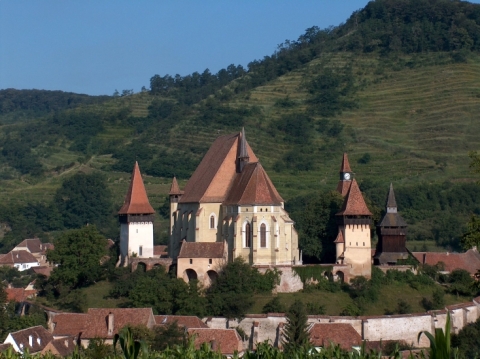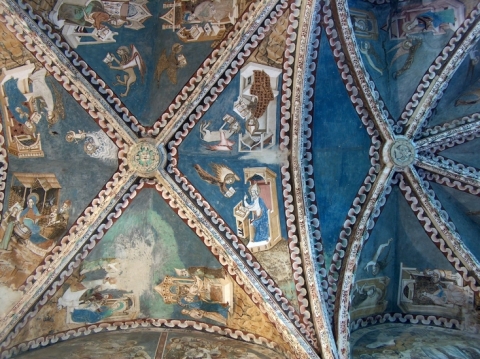Medieval History
The southern part of Transylvania has been populated by settlers from various (mainly the westernmost) parts of Germany, generally termed Saxons in medieval and more recent sources (you can read their history here). These Saxon settlers built some of the most urban settlements of Transylvania - cities such as Kronstadt (Brassó/Brasov), Hermannstadt (Nagyszeben/Sibiu) or Schässburg (Segesvár/Sighisoara). The villages of that region largely preserved their medieval structure to this day, and most are dominated by large medieval churches. Over the course of the 15-17th centuries, as the territory was under constant threat by the Ottoman Empire, these churches were all fortified - some built into veritable castles. Transylvanian Saxons became Lutheran during the 16th century, thus these churches preserved much of their medieval treasures - including altarpieces, goldsmith works, liturgical textiles, Turkish rugs - to this day. These days, more and more frescoes are also coming to light from under the whitewash in these churches. Owing to the mass exodus of Transylvanian Saxons to Germany during the 1980s-1990s, many of these churches are out of use today, some completely abandoned. However, more and more is done to preserve this rich heritage. The churches of the region of Hermannstadt have been put on the watch-list of the World Monument Fund, while seven churches and the historic center of Schässburg are on the Unesco World Heritage list. International conservation efforts have been quite successful in some cases, as with the Church on the Hill in Schässburg, and Prince Charles has taken an interest in the region, buying property there.
In this post, I would like to call attention to a website aimed at documenting the Saxon churches of Transylvania. The website Fortified Churches provides information on the region in five languages, with photo galleries of many of the churches (browse them under Locations). It is well worth a visit - although the best of course is visit the region in person, something I can highly recommend.
(Pictures in this post are from the Fortified Churches website. See also my earlier post on Abandoned medieval churches in Transylvania).
- Medieval England To Be Featured In Two Bbc Shows
Television viewers in the United Kingdom will have the chance to watch two new history programmes that feature medieval England. The BBC will start airing a new six-part series, Churches: How to Read Them, on September 1st on BBC Four. Presented by author...
- Catalogue Of Liturgical Vestments Of The Black Church In Brasov
The Abbeg-Stiftung (Riggisberg, CH) published an exhaustive catalogue of the liturgical vestments of the Black Church of Bra?ov / Brassó / Kronstadt in Transylvania. Regarded as the most important ecclesiastical collection of the Transylvanian Saxon...
- The Route Of Medieval Churches In Szatmár County
Csengersima, parish church A major research project, aimed at surveying and documenting the churches of medieval Szatmár country, was completed last week, and its results are now largely available on the web. As the territory of medieval Szatmár...
- Abandoned Medieval Churches In Transylvania
The Calvinist church of Marosszentimre (Sântimbru) in Transylvania I would like to start this post by a poem written by my grandfather, Zoltán Jékely, in 1936. The translation included here is by Bernard S. Adams.1 ol{margin:0;padding:0}p{margin:0}.c4{vertical-align:top;width:233.25pt;border-style:solid;border-color:#000000;border-width:0pt;padding:5.0pt...
- Castles In Medieval Hungary
View of Visegrád The territory of medieval Hungary was very rich in castles. Castles served as the centers of royal counties, and they were also the centers of noble estates. The first large wave of castle-building took place during the second half...
Medieval History
Fortified Saxon churches of Transylania
 |
| Birthälm (Berethalom/Biertan) |
 |
| Malmkrog (Almakerék/Malancrav) |
In this post, I would like to call attention to a website aimed at documenting the Saxon churches of Transylvania. The website Fortified Churches provides information on the region in five languages, with photo galleries of many of the churches (browse them under Locations). It is well worth a visit - although the best of course is visit the region in person, something I can highly recommend.
(Pictures in this post are from the Fortified Churches website. See also my earlier post on Abandoned medieval churches in Transylvania).
- Medieval England To Be Featured In Two Bbc Shows
Television viewers in the United Kingdom will have the chance to watch two new history programmes that feature medieval England. The BBC will start airing a new six-part series, Churches: How to Read Them, on September 1st on BBC Four. Presented by author...
- Catalogue Of Liturgical Vestments Of The Black Church In Brasov
The Abbeg-Stiftung (Riggisberg, CH) published an exhaustive catalogue of the liturgical vestments of the Black Church of Bra?ov / Brassó / Kronstadt in Transylvania. Regarded as the most important ecclesiastical collection of the Transylvanian Saxon...
- The Route Of Medieval Churches In Szatmár County
Csengersima, parish church A major research project, aimed at surveying and documenting the churches of medieval Szatmár country, was completed last week, and its results are now largely available on the web. As the territory of medieval Szatmár...
- Abandoned Medieval Churches In Transylvania
The Calvinist church of Marosszentimre (Sântimbru) in Transylvania I would like to start this post by a poem written by my grandfather, Zoltán Jékely, in 1936. The translation included here is by Bernard S. Adams.1 ol{margin:0;padding:0}p{margin:0}.c4{vertical-align:top;width:233.25pt;border-style:solid;border-color:#000000;border-width:0pt;padding:5.0pt...
- Castles In Medieval Hungary
View of Visegrád The territory of medieval Hungary was very rich in castles. Castles served as the centers of royal counties, and they were also the centers of noble estates. The first large wave of castle-building took place during the second half...
